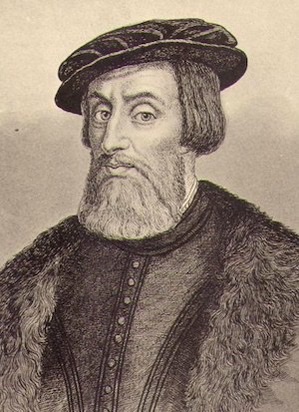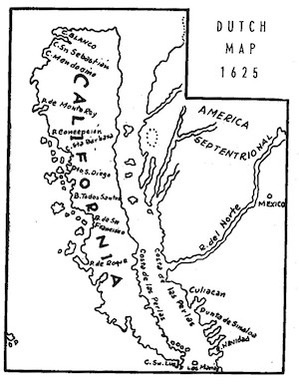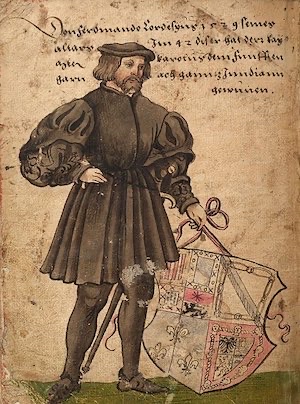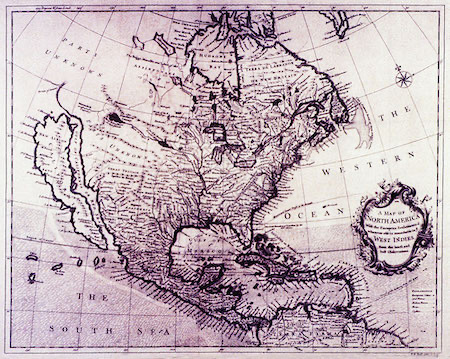 |  |
By Greg Niemann

It was conquistador Hernán Cortés, the conqueror of Mexico, who personally went on to Baja California in 1535 to establish the peninsula’s first settlement, brief though it was. After claiming Mexico for the Spanish crown in 1519-21, and Honduras (1524-25), Cortés continued to lead expeditions for Spain in the New World.
The further westward explorations of Cortés and others were driven by, and enhanced by, some fantastic stories and myths.
Throughout history, few subjects have fired up man’s imagination more than the prospect of instant riches. And if you throw in a legend about beautiful women, you’ve got a box office hit. In the case of “California” in the early 16th century, you’ve got the ingredients for the intrigue that surrounded that mythical “island.”
Following the discovery of great wealth in Mexico and Peru, the Spaniards were willing to believe anything. Fancy was so attractive it became fact.
The popular Spanish novel “Sergas (The Exploits of) de Esplandian” told about Amazon women of “beautiful robust bodies” on an island where gold was the only metal. The unknown land had to be out there somewhere, and Mexico became filled with adventurers who sought it, further spreading tall tales. Even Hernán Cortés was taken in by the myth and wrote the King of Spain that he would seek its truth.
In addition, an old European legend about seven cities of gold in a place called Cibola was resurrected by Cabeza de Vaca and his handful of men who wandered lost for eight years throughout what is now the Southwest United States. They claim to have seen the cities shimmering in the sunlight from a distance. Resolute adventurers searched for both legends over the next century and eventually settled for the realities that the seven cities were yellow clay Indian pueblos, and that the “island” of California had neither Amazons nor the riches they sought. Nor was California an island. They also searched for a “northwest passage” that would expedite ships heading to the Orient. It took them a long time to dispel the stories yet many died trying, and Cortés was involved in these pursuits.

Enamored by the stories, Cortés sent ships to seek the land inspired by legend, that mythical “island of riches” that became California. In 1532 his first two ships didn’t get far, landing back on the Mexican mainland on the east side of the gulf (Gulf of California). One ship turned back in a storm and the crew of the other, commanded by Cortés’ cousin, were all killed by natives on the mainland.
He sent two more ships late in 1533 but they separated and the first one returned to Acapulco. The other ship, the “Concepcion,” was commanded by another Cortés relative, Diego Becerra de Mendoza who was not well liked. The crew mutinied, killing him in his sleep, and established the Basque pilot Fortun Jimenez in command. They stopped on the mainland coast north of Acapulco and sent Becerra’s sympathizers ashore and set about fleeing to the north.
A storm blew the fugitives west by mistake into what is now La Paz, making them the first Europeans to set foot on (Baja) California. Unfortunately, most of the men didn’t live to tell about it as local Indians killed Jimenez and 20 of his men.
The 18 survivors fled, sailing back across the gulf only to fall into the hands of Cortés’ arch-rival Nuño de Guzman. Most were killed, but at least one escaped to relate to Cortés the tale of the landing in the new “island” to the west where there were many pearls. One historical report indicated there were two surviving seamen who told Cortés that there was “good evidence of pearls.”
Thus the actual discovery of California by Europeans was an ignoble result of treachery, storms, mistakes, mutiny and counter-mutiny, all shrouded in violence, perpetrated by both the fugitive visitors and those whose homes and cultures were endangered.
Cortés Colony Short Lived
After hearing about the pearls and potential wealth in this “island” to the west, Cortés was encouraged. He used his own money, took three ships, a total of about 500 Spaniards who would establish a settlement, and set out to colonize the new land.
They crossed the gulf and on May 3, 1535, the party landed in what Cortés named Santa Cruz, the northeast corner of La Paz Bay, on what they called the Isle of Pearls.
The Cortés party found evidence of the earlier Jimenez landing and giving credence to the reports, also found pearls in great abundance, at least 30 pearl oyster beds. It appeared, however, that most were deep and would require diving, but they began what would be a centuries long pearl industry.

From the start, Cortés had problems supporting the colony. Not only were they attacked by the native Guaycura, but they found the land too arid to support them. Cortés had the ships return to the mainland to pick up additional colonists and supplies, but they had such bad luck that only one returned, and without any provisions at that.
Cortés himself took off back to the mainland with the remaining ship to discover that one vessel had run aground on the coast of Sinaloa which they were able to release. The other was severely damaged upon a reef. Using the one ship able to sail, they also had a hard time getting supplies.
To further complicate matters, the pilot died on the journey back to the colony, so Cortés himself had to take the wheel. When they finally returned to Santa Cruz (La Paz) they discovered 23 of the colonists dead from starvation and a few others soon died from gorging themselves when food arrived.
The colony built a church and housing but could not sustain themselves from the land nor count on consistent supplies. Cortés abandoned the colony and the last of the colonists returned to the Mexican mainland in 1536. Cortés spent a fortune on this year-long enterprise and had nothing to show for it other than a few nice pearls, including one that was allegedly valued at 5,000 ducats, however much that totaled considering that at the time each ducat contained 3.5 grams of gold.
Cortés was to get another expedition as he still wanted to find the lost city of Cibola gold legend and the fabled “northwest passage” strait. In 1539, before he returned to Spain, he sent Francisco de Ulloa north along the mainland coast from Acapulco in search of Cibola. Their three small ships made it to the Colorado River delta but they did not determine if it was a river or a strait to the South Sea (Pacific Ocean).

They sailed down the western shore, rounded the cape of San Lucas and went as far north as Punta Baja which they named Cape Disappointment, “a fitting term for Cortés’ last exploration” said one historian. They discovered neither gold, nor riches, nor did they confirm whether Baja was an island. The Gulf of California was renamed the Sea of Cortéz in the conquistador’s honor.
The former Governor of New Spain and leader of the expedition that caused the fall of the Aztec Empire, Hernán Cortés died in Spain in 1547. While he had some disappointments himself, all of his explorations provided enlightened information and data for those who followed him.
He conquered mainland Mexico and Honduras, but as many visitors have learned through the years, Baja California proved to be a challenge.
About Greg
Greg Niemann, a long-time Baja writer, is the author of Baja Fever, Baja Legends, Palm Springs Legends, Las Vegas Legends, and Big Brown: The Untold Story of UPS. Visit www.gregniemann.com.

great company to work with! Easy to obtain, thank you!

I can't think of an easier way to get Mexican insurance; just one call on my departure day and I...